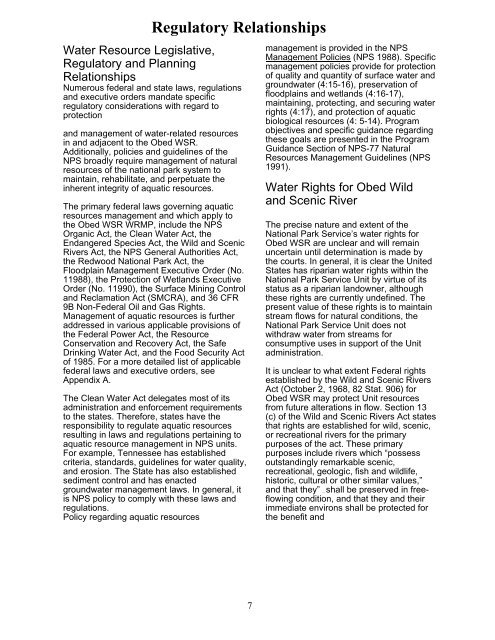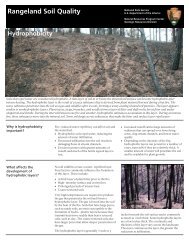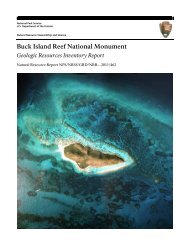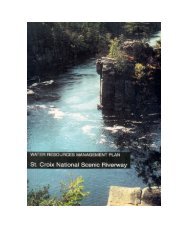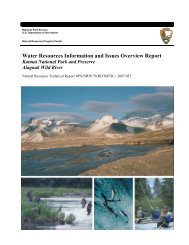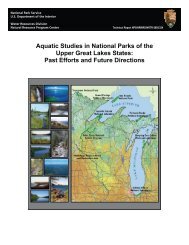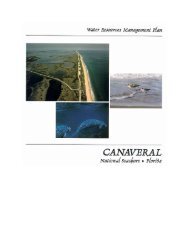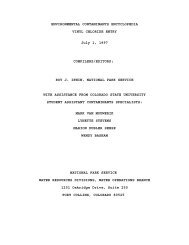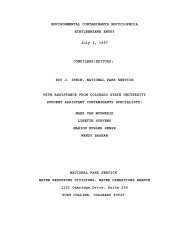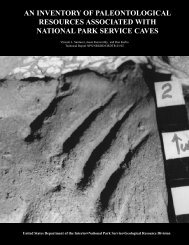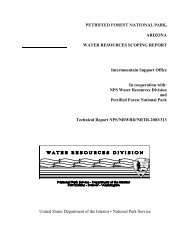Obed Wild and Scenic River - Explore Nature - National Park Service
Obed Wild and Scenic River - Explore Nature - National Park Service
Obed Wild and Scenic River - Explore Nature - National Park Service
You also want an ePaper? Increase the reach of your titles
YUMPU automatically turns print PDFs into web optimized ePapers that Google loves.
Regulatory Relationships<br />
Water Resource Legislative,<br />
Regulatory <strong>and</strong> Planning<br />
Relationships<br />
Numerous federal <strong>and</strong> state laws, regulations<br />
<strong>and</strong> executive orders m<strong>and</strong>ate specific<br />
regulatory considerations with regard to<br />
protection<br />
<strong>and</strong> management of water-related resources<br />
in <strong>and</strong> adjacent to the <strong>Obed</strong> WSR.<br />
Additionally, policies <strong>and</strong> guidelines of the<br />
NPS broadly require management of natural<br />
resources of the national park system to<br />
maintain, rehabilitate, <strong>and</strong> perpetuate the<br />
inherent integrity of aquatic resources.<br />
The primary federal laws governing aquatic<br />
resources management <strong>and</strong> which apply to<br />
the <strong>Obed</strong> WSR WRMP, include the NPS<br />
Organic Act, the Clean Water Act, the<br />
Endangered Species Act, the <strong>Wild</strong> <strong>and</strong> <strong>Scenic</strong><br />
<strong>River</strong>s Act, the NPS General Authorities Act,<br />
the Redwood <strong>National</strong> <strong>Park</strong> Act, the<br />
Floodplain Management Executive Order (No.<br />
11988), the Protection of Wetl<strong>and</strong>s Executive<br />
Order (No. 11990), the Surface Mining Control<br />
<strong>and</strong> Reclamation Act (SMCRA), <strong>and</strong> 36 CFR<br />
9B Non-Federal Oil <strong>and</strong> Gas Rights.<br />
Management of aquatic resources is further<br />
addressed in various applicable provisions of<br />
the Federal Power Act, the Resource<br />
Conservation <strong>and</strong> Recovery Act, the Safe<br />
Drinking Water Act, <strong>and</strong> the Food Security Act<br />
of 1985. For a more detailed list of applicable<br />
federal laws <strong>and</strong> executive orders, see<br />
Appendix A.<br />
The Clean Water Act delegates most of its<br />
administration <strong>and</strong> enforcement requirements<br />
to the states. Therefore, states have the<br />
responsibility to regulate aquatic resources<br />
resulting in laws <strong>and</strong> regulations pertaining to<br />
aquatic resource management in NPS units.<br />
For example, Tennessee has established<br />
criteria, st<strong>and</strong>ards, guidelines for water quality,<br />
<strong>and</strong> erosion. The State has also established<br />
sediment control <strong>and</strong> has enacted<br />
groundwater management laws. In general, it<br />
is NPS policy to comply with these laws <strong>and</strong><br />
regulations.<br />
Policy regarding aquatic resources<br />
7<br />
management is provided in the NPS<br />
Management Policies (NPS 1988). Specific<br />
management policies provide for protection<br />
of quality <strong>and</strong> quantity of surface water <strong>and</strong><br />
groundwater (4:15-16), preservation of<br />
floodplains <strong>and</strong> wetl<strong>and</strong>s (4:16-17),<br />
maintaining, protecting, <strong>and</strong> securing water<br />
rights (4:17), <strong>and</strong> protection of aquatic<br />
biological resources (4: 5-14). Program<br />
objectives <strong>and</strong> specific guidance regarding<br />
these goals are presented in the Program<br />
Guidance Section of NPS-77 Natural<br />
Resources Management Guidelines (NPS<br />
1991).<br />
Water Rights for <strong>Obed</strong> <strong>Wild</strong><br />
<strong>and</strong> <strong>Scenic</strong> <strong>River</strong><br />
The precise nature <strong>and</strong> extent of the<br />
<strong>National</strong> <strong>Park</strong> <strong>Service</strong>’s water rights for<br />
<strong>Obed</strong> WSR are unclear <strong>and</strong> will remain<br />
uncertain until determination is made by<br />
the courts. In general, it is clear the United<br />
States has riparian water rights within the<br />
<strong>National</strong> <strong>Park</strong> <strong>Service</strong> Unit by virtue of its<br />
status as a riparian l<strong>and</strong>owner, although<br />
these rights are currently undefined. The<br />
present value of these rights is to maintain<br />
stream flows for natural conditions, the<br />
<strong>National</strong> <strong>Park</strong> <strong>Service</strong> Unit does not<br />
withdraw water from streams for<br />
consumptive uses in support of the Unit<br />
administration.<br />
It is unclear to what extent Federal rights<br />
established by the <strong>Wild</strong> <strong>and</strong> <strong>Scenic</strong> <strong>River</strong>s<br />
Act (October 2, 1968, 82 Stat. 906) for<br />
<strong>Obed</strong> WSR may protect Unit resources<br />
from future alterations in flow. Section 13<br />
(c) of the <strong>Wild</strong> <strong>and</strong> <strong>Scenic</strong> <strong>River</strong>s Act states<br />
that rights are established for wild, scenic,<br />
or recreational rivers for the primary<br />
purposes of the act. These primary<br />
purposes include rivers which “possess<br />
outst<strong>and</strong>ingly remarkable scenic,<br />
recreational, geologic, fish <strong>and</strong> wildlife,<br />
historic, cultural or other similar values,”<br />
<strong>and</strong> that they” ... shall be preserved in freeflowing<br />
condition, <strong>and</strong> that they <strong>and</strong> their<br />
immediate environs shall be protected for<br />
the benefit <strong>and</strong>


